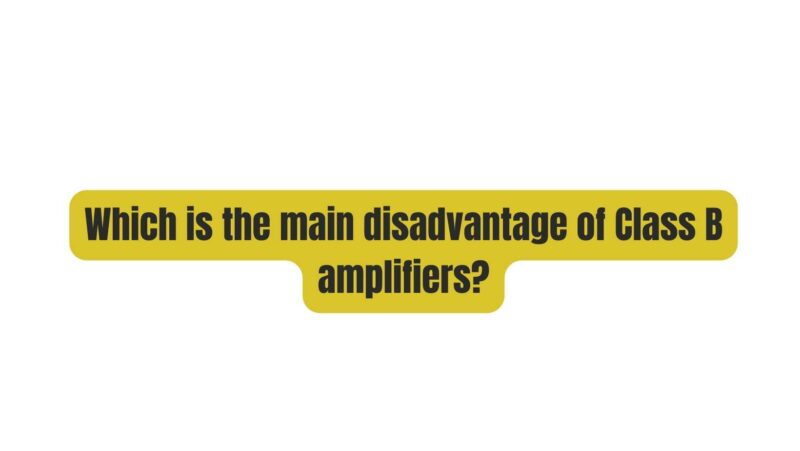Class B amplifiers have been a cornerstone of audio amplification for many years, praised for their efficiency and ability to deliver substantial power with reduced heat generation. However, despite their advantages, Class B amplifiers exhibit a crucial disadvantage that has implications for audio quality. In this article, we will delve into the primary disadvantage of Class B amplifiers, offering insights into the challenges it presents in the realm of audio amplification.
1. Crossover Distortion: The Predominant Disadvantage
The main disadvantage associated with Class B amplifiers is crossover distortion. This phenomenon occurs at the point where the amplification switches from one transistor to another in a push-pull configuration. During this transition, there is a brief moment when neither transistor conducts, leading to a distortion in the output waveform. This distortion manifests as a notch or irregularity near the zero-crossing point of the amplified signal.
1.1 Impact on Sound Quality
The impact of crossover distortion on sound quality cannot be overstated, especially in high-fidelity audio applications. Even though the distortion is typically minimal at higher signal amplitudes, it becomes increasingly noticeable at low signal levels. Audiophiles and professionals who prioritize pristine sound reproduction often opt for Class A or Class AB amplifiers due to their lower crossover distortion and superior audio quality.
1.2 Audible Artifacts
Crossover distortion introduces audible artifacts into the output signal. These artifacts can manifest as clicks, pops, or subtle distortions that degrade the fidelity of the reproduced audio. In applications where accuracy and faithfulness to the source material are paramount, such as studio recording or high-end home audio systems, crossover distortion becomes a significant limitation.
2. The Mechanism Behind Crossover Distortion
Understanding the mechanism behind crossover distortion helps clarify why it is a fundamental limitation of Class B amplifiers. In a Class B amplifier, the signal is divided into two halves: the positive half and the negative half. Each half is handled by a separate transistor (one NPN and one PNP transistor in a push-pull configuration).
2.1 The Notch at Crossover
As the amplified signal transitions from one half to the other, there is a moment when neither transistor is conducting, resulting in a voltage gap. This gap creates a noticeable notch or irregularity in the output waveform, causing crossover distortion. The depth and duration of this distortion depend on the precise matching of the transistors and the biasing of the amplifier.
3. Attempts to Mitigate Crossover Distortion
Efforts have been made over the years to mitigate crossover distortion in Class B amplifiers. These attempts include:
3.1 Class AB Amplification
One common approach is the use of Class AB amplification, which combines elements of Class A and Class B amplifiers. In Class AB amplifiers, each transistor conducts slightly beyond the point where it would switch off entirely, reducing the gap and mitigating crossover distortion. While this approach improves distortion characteristics, it does so at the expense of efficiency, as both transistors conduct simultaneously during the transition.
3.2 Feedback and Compensation Circuits
Designers have also implemented feedback and compensation circuits to address crossover distortion. These circuits actively adjust the biasing of the transistors to minimize distortion during the crossover region. While they can improve performance, they add complexity and cost to the amplifier design.
4. Real-World Applications
The impact of crossover distortion varies depending on the specific application and the quality standards required:
4.1 High-Fidelity Audio Systems
In high-fidelity audio systems, where audio quality is paramount, crossover distortion is a critical concern. Audiophiles and music enthusiasts often invest in amplifiers with minimal distortion, such as Class A or high-quality Class AB designs, to ensure a pristine listening experience.
4.2 Pro Audio and Recording
In professional audio and recording studios, minimizing distortion is essential to capture accurate and unaltered audio recordings. Crossover distortion can introduce unwanted artifacts into the recorded material, making it less suitable for critical applications.
4.3 Consumer Electronics
For many consumer electronics applications, such as home theater systems and portable speakers, the impact of crossover distortion may be less noticeable due to the nature of the content and the listening environment. Cost considerations often lead to the use of Class B amplifiers in these applications.
Conclusion
While Class B amplifiers offer high efficiency and power output, they are plagued by the significant disadvantage of crossover distortion, which can compromise audio quality in critical listening environments. This limitation has driven the development and adoption of alternative amplifier classes, such as Class A and Class AB, in applications where sound quality is of paramount importance. Designers and users must carefully consider the trade-offs and choose amplifiers that best align with their specific requirements, whether it’s high efficiency, high fidelity, or a balance between the two, to achieve the desired audio amplification performance.


